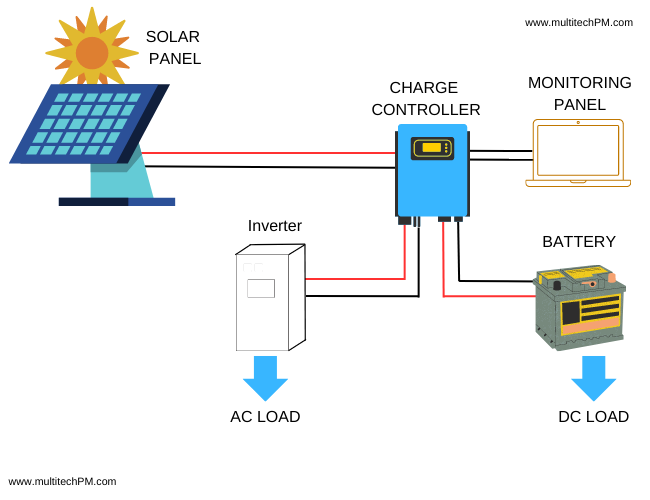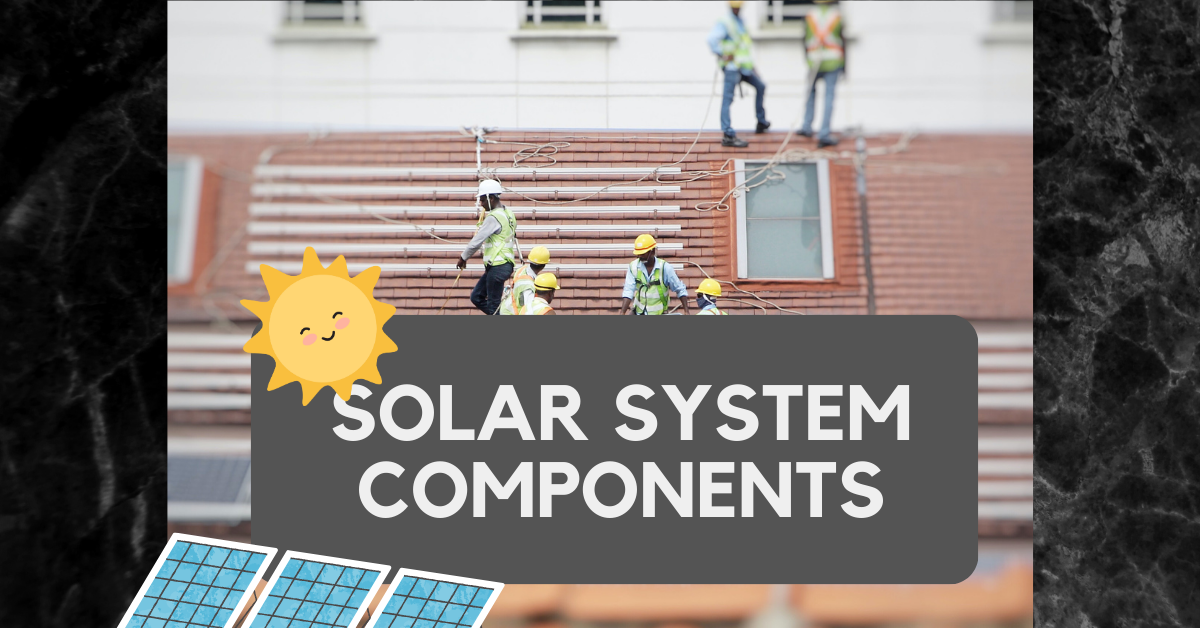In this post, we’ll explore the key solar system components and understand their functions.
With the rising popularity of renewable energy sources, solar power has emerged as a clean and sustainable solution to meet our energy needs. A solar system is made up of various components, each playing a crucial role in harnessing the sun’s energy and converting it into electricity. Below are the basic components of a solar system.
Components of a Solar System
The diagram below depicts the fundamental components and layout of a solar system. The sequence commences with the solar panel securely positioned on its designated mounting or racking. This panel is then linked to the Charge Controller, which oversees, observes, and administers the energy derived from the panel, subsequently directing it towards the battery or inverter. The battery and inverters are interconnected with the controller.

Solar Panels
Solar panels are the heart of any solar system. They consist of photovoltaic cells that convert sunlight into electricity. These panels come in various types, such as monocrystalline, polycrystalline, and thin-film, each with its own efficiency and cost considerations. High-quality solar panels ensure better energy production and longer system lifespan. Check out this post for more detailed explanation on how solar cells create electricity.
Panels are usually connected in series or parallel connection to achieve the required output depending on computations on the load, hourly demands, local weather conditions, etc.
Racking and Mounting Systems:
While it may not be the central component of a solar system, it holds significant importance and deserves a mention. Regardless of how robust your system might be, the absence of proper racking can lead to an insecure setup susceptible to collapse, resulting in substantial financial losses. Racking and mounting systems play a pivotal role by furnishing essential support and ensuring the secure placement of solar panels. These systems are engineered to endure diverse weather conditions while also fine-tuning the angle of the panels to optimize energy absorption. The correct installation of racking and mounting systems stands as a critical factor influencing the overall efficiency and long-term resilience of the entire solar system.
Solar Inverter
The electricity generated by solar panels is in DC form, while most of our household appliances use AC electricity. The solar inverter’s primary function is to convert the DC electricity from the panels into usable AC electricity. There are three main types of inverters: string inverters, microinverters, and power optimizers. Each has its advantages and is chosen based on the specific solar system requirements.
Solar Batteries
Solar batteries are elements designed to store the energy produced by the solar panels. The utility of batteries is especially notable in configurations like off-grid setups or hybrid setups, which depend on the specific arrangement you have. In essence, these setups imply that you are either not linked to the electricity grid provided by conventional utility companies, or you rely on the grid once your battery charge has been used up. Such instances commonly occur during nighttime, instances of reduced sunlight, or when power outages arise. Proficient battery storage systems substantially bolster self-reliance regarding energy and possess the capability to diminish dependence on the conventional power grid.
Charge Controllers
Charge controllers regulate the flow of electricity between the solar panels and batteries. They prevent overcharging and excessive discharging of batteries, which can damage their performance and lifespan. Modern charge controllers often come with smart features and monitoring capabilities, enabling efficient energy management.
Monitoring and Control Systems
Monitoring and control systems provide real-time data about the solar system’s performance, energy production, and consumption. Homeowners can track their energy usage patterns, identify potential issues, and optimize system performance through user-friendly interfaces or mobile apps.
Conclusion:
A solar system is a well-orchestrated combination of various components, working in harmony to harness the sun’s energy and provide clean electricity. Understanding each component’s role is crucial for designing and maintaining an efficient and reliable solar system. By investing in high-quality solar components and proper installation, homeowners can benefit from reduced energy bills, lower environmental impact, and greater energy independence. We have compiled some benefits and advantages of using the solar system. Please check it out and decide if this is the right one for you.

